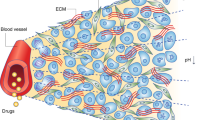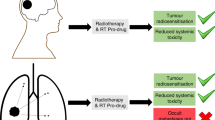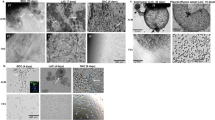Abstract
Preclinical studies demonstrate that in vivo AQ4N enhances the anti-tumour effects of radiation and chemotherapeutic agents with a dose-modifying factor of approximately 2.0. With careful scheduling no, or very little, additional normal tissue toxicity should be observed. AQ4N is a bioreductive prodrug of a potent, stable, reduction product which binds non-covalently to DNA, facilitating antitumour activity in both hypoxic and proximate oxic tumour cells. AQ4N is clearly different in both its mechanism of action and potential bystander effect compared to previously identified bioreductive drugs. In particular AQ4N is the only bioreductive prodrug topoisomerase II inhibitor to enter clinical trials. Targeting this enzyme, which is crucial to cell division, may help sensitize tumours to repeated (fractionated) courses of radiotherapy. This is because in principle, the bioreduction product of AQ4N can inhibit the topoisomerase activity of hypoxic cells as they attempt to re-enter the cell cycle. © 2000 Cancer Research Campaign http://www.bjcancer.com
Similar content being viewed by others
Article PDF
Change history
16 November 2011
This paper was modified 12 months after initial publication to switch to Creative Commons licence terms, as noted at publication
References
Brown JM (1999) The hypoxic cell: a target for selective cancer therapy – 18th Bruce F. Caine Memorial Award Lecture. Cancer Res 59( 23): 5863–5870
Brown JM (2000) Exploiting the hypoxic cancer cell: mechanisms and therapeutic strategies. Mol Med Today 6(4): 157–162
Fisher GR and Patterson LH (1992) Lack of involvement of reactive oxygen in the cytotoxicity of mitoxantrone, CI941 and ametantrone in MCF-7 cells: comparison with doxorubicin. Cancer Chemother Pharmacol 30(6): 451–458
Friery OP, Gallagher R, Murray MM, Hughes CM, Galligan ES, McIntyre IA, Patterson LH, Hirst DG and McKeown SR (2000) Enhancement of the anti-tumour effect of cyclophosphamide by the bioreductive drugs AQ4N and tirapazamine. Br J Cancer 2(8): 1469–1473
Garner AP, Paine MJ, Rodriguez-Crespo I, Chinje EC, Ortiz De Montallano P, Stratford IJ, Tew DG and Wolf CR (1999) Nitric oxide synthases catalyse the activation of redox cycling and bioreductive anticancer agents. Cancer Res 59(8): 1929–1934
Graeber TG, Osmanian C, Jacks T, Housman DE, Koch CJ, Loke SW and Giaccia AJ (1996) Hypoxia-mediated selection of cells with diminished apoptotic potential in solid tumours. Nature 379(6560): 88–91
Hejmadi MV, McKeown SR, Friery OP, McIntyre IA, Patterson LH and Hirst DG (1996) DNA damage following combination of radiation with the bioreductive drug AQ4N: possible selective toxicity to oxic and hypoxic tumour cells. Br J Cancer 73(4): 499–505
Koch J (1993) Unusual oxygen concentration-dependence of toxicity of SR-4233, a hypoxic cell cytotoxin. Cancer Res 53(17): 3992–3997
Lee HH and Denny WAA (1999) large-scale synthesis of the bioreductive drug 1,4-bis{[2-(dimethylamino)ethyl]amino}-5,8-dihydroxyanthracene-9,10-dione bis-N-oxide (AQ4N). J Chem Soc Perkins Trans I 19: 2755–2758
Lee AE and Wilson WR (2000) Hypoxia-dependent retinal toxicity of bioreductive anticancer prodrugs in mice. Toxicol Appl Pharmacol 163(1): 50–59
McKeown SR, Hejmadi MV, McIntyre IA, McAleer JJ and Patterson LH (1995) AQ4N: an alkylaminoanthraquinone N-oxide showing bioreductive potential and positive interaction with radiation in vivo. Br J Cancer 72(1): 76–81
McKeown SR, Friery OP, McIntyre IA, Hejmadi MV, Patterson LH and Hirst DG (1996) Evidence for a therapeutic gain when AQ4N or tirapazamine is combined with radiation. Br J Cancer Suppl 27: S39–42
Murray GI, McFadyen MCE, Mitchell RT, Cheung YL, Kerr AC and Melvin WT (1999) Cytochrome P450CYP3A in human renal cell cancer. British Journal of Cancer 79: 1836–1842
Patterson LH (1993) Rationale for the use of aliphatic N-oxides of cytotoxic anthraquinones as prodrug DNA binding agents: a new class of bioreductive agent. Cancer Metastasis Rev 12(2): 119–134
Patterson LH and Raleigh SM (1998) Reductive metabolism: Its application to prodrug activation. In: NJ Gooderham (ed) Drug Metabolism: Towards the Next Millennium. IOS Press: Amsterdam, pp. 72–79
Patterson LH, Craven MR, Fisher GR and Teesdale-Spittle P (1994) Aliphatic amine N-oxides of DNA binding agents as bioreductive drugs. Oncol Res 6(10–11): 533–538
Patterson AV, Saunders MP, Chinje EC, Patterson LH and ratford IJ (1998) Enzymology of tirapazamine metabolism: a review. Anticancer Drug Des 13: 541–573
Patterson LH, McKeown SR, Robson T, Gallagher R, Raleigh SM and Orr S (1999) Antitumour prodrug development using cytochrome P450 (CYP) mediated activation. Anticancer Drug Des 14(6): 473–486
Patterson LH, McKeown SR, Ruparelia K, Double JA, Bibby MC, Cole S and Stratford IJ (2000) Enhancement of chemotherapy and radiotherapy of murine tumours by AQ4N, a bioreductively activated anti-tumour agent. Br J Cancer 82(12): 1984–1990
Raleigh SM (1998) Involvement of cytochrome P450 (CYP) and other haem associated enzymes in the bioreduction of AQ4N, an antitumour produrg. PhD thesis, De Montfort University, Leicester
Raleigh SM, Wanogho E, Burke MD, McKeown SR and Patterson LH (1998) Involvement of human cytochromes P450 (CYP) in the reductive metabolism of AQ4N, a hypoxia activated anthraquinone di-N-oxide prodrug. Int J Radiat Oncol Biol Phys 42(4): 763–767
Raleigh SM, Wanogho E, Burke MD and Patterson LH (1999) Rat cytochromes P450 (CYP) specifically contribute to the reductive bioactivation of AQ4N, an alkylaminoanthraquinone-di-N-oxide anticancer prodrug. Xenobiotica (11): 1115–1122
Saunders MP, Patterson AV, Chinje EC, Harris AL and Stratford IJ (2000) NADPH: cytochrome c(P450) reductase activates tirapazamine (SR4233) to restore hypoxic and oxic cytotoxicity in an aerobic resistant derivative of the A549 lung cancer cell line. Br J Cancer 82(3): 651–656
Smith PJ, Desnoyers R, Blunt N, Giles Y, Patterson LH and Watson JV (1997a) Flow cytometric analysis and confocal imaging of anticancer alkylaminoanthraquinones and their N-oxides in intact human cells using 647-nm krypton laser excitation. Cytometry 27( 1): 43–53
Smith PJ, Blunt NJ, Desnoyers R, Giles Y and Patterson LH (1997b) DNA topoisomerase II-dependent cytotoxicity to alkylaminoanthraquinones and their N-oxides. Cancer Chemother Pharmacol 39(5): 455–461
Swaine DJ, Loadman PM, Bibby MC, Graham MA and Patterson LH (2000) High-performance liquid chromatographic analysis of AQ4N, an alkylaminoanthraquinone N-oxide. J Chromatogr B Biomed Sci Appl 742(2): 239–245
Thomsen LL, Lawton FG, Knowles RG, Beesley JE, Riveros-Moreno V and Moncada S (1994) Nitric oxide synthase activity in human gynaecological cancer. Cancer Res 54( 5): 1352–1354
Thomsen LL, Miles DW, Happerfield L, Bobrow LG, Knowles RG and Moncada S (1995) Nitric oxide synthase activity in human breast cancer. Br J Cancer 72( 1): 41–44
Wilson WR, Denny WA, Pullen SM, Thompson KM, Li AE, Patterson LH and Lee HH (1996) Tertiary amine N-oxides as bioreductive drugs: DACA N-oxide, nitracrine N-oxide and AQ4N. Br J Cancer Suppl 27: S43–47
Author information
Authors and Affiliations
Rights and permissions
From twelve months after its original publication, this work is licensed under the Creative Commons Attribution-NonCommercial-Share Alike 3.0 Unported License. To view a copy of this license, visit http://creativecommons.org/licenses/by-nc-sa/3.0/
About this article
Cite this article
Patterson, L., McKeown, S. AQ4N: a new approach to hypoxia-activated cancer chemotherapy. Br J Cancer 83, 1589–1593 (2000). https://doi.org/10.1054/bjoc.2000.1564
Received:
Accepted:
Published:
Issue date:
DOI: https://doi.org/10.1054/bjoc.2000.1564
Keywords
This article is cited by
-
Combinatory anti-tumor activities of 1,4-bis[2-(dimethylamino)ethylamino]-5,8-dihydroxyanthracene-9,10-dione (AQ4) and temsirolimus against colorectal cancer cells
Journal of Cancer Research and Clinical Oncology (2023)
-
Cytochrome P450 isoforms 1A1, 1B1 AND 2W1 as targets for therapeutic intervention in head and neck cancer
Scientific Reports (2021)
-
Dissecting and rebuilding the glioblastoma microenvironment with engineered materials
Nature Reviews Materials (2019)
-
Established Models and New Paradigms for Hypoxia-Driven Cancer-Associated Bone Disease
Calcified Tissue International (2018)
-
A bioreducible N-oxide-based probe for photoacoustic imaging of hypoxia
Nature Communications (2017)



